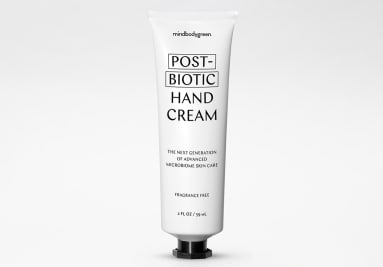
mbg Beauty Director
mbg Beauty Director
Alexandra Engler is the beauty director at mindbodygreen and host of the beauty podcast Clean Beauty School. Previously, she’s held beauty roles at Harper’s Bazaar, Marie Claire, SELF, and Cosmopolitan; her byline has appeared in Esquire, Sports Illustrated, and Allure.com.

Image by Studio Firma / Stocksy
March 7, 2023
To say that microbiome has a profound effect on the appearance and health of the skin would be an understatement. It would also be, well, slightly inaccurate. Your skin microbiome not only influences your skin, it’s actually part of it—helping create the barrier function, producing essential postbiotics (like hyaluronic acid, essential fatty acids, and peptides), warding off environmental stressors, enhancing the immune system, and more.
While this is a relatively new area of research, we’re constantly learning more about how vital this skin flora is and how many functions it really has. And one untapped area of study is the biome’s role in collagen production and degradation. Well, recent research suggests that there may be an important relationship to uncover.
Advertisement
This ad is displayed using third party content and we do not control its accessibility features.
What are collagen and the skin microbiome, and what do they have to do with one another?
Just to go over the basics, collagen is a structural protein in the skin. It can help keep the skin firm and tout. It also declines with age, starting at some point in the late 20s and early 30s. While this decline is natural (and in a lot of ways, unavoidable), certain lifestyle factors can contribute to it such as excessive UV exposure, inflammation, damaging topicals, and stress.
The skin microbiome is the collection of the trillions of organisms that live on the skin. As I’ve noted, there’s a lot we don’t know about it, but we do know that it communicates with our immune system, manages inflammation, protects against environmental stressors, and produces vital nutrients for the skin (called postbiotics). We also know that the organisms that make up the microbiome are dynamic and ever-changing. Lots of things can influence which species live on and dominate your skin, such as your age, hormones, your environment, and more.
On the subject of age-related changes to the microbiome, there seems to be a connection between loss of microbiome diversity and collagen production. Recent research (that has yet to be peer reviewed) identified some key differences in the microbiomes of women in their 50s versus women in their 20s. One of their findings that the researchers are still exploring is that participants who had certain strains of the bacterial species Cutibacterium acnes and Staphylococcus epidermidis also had a decline of collagen levels in the skin. It’s notable because the strains they identified had also been previously associated with inflammation in the skin.
However, many researchers in the space (like those of this review1) also note that more studies are needed to understand the complicated and multifactorial interplay between the skin microbiome and our overall skin health1.
Advertisement
This ad is displayed using third party content and we do not control its accessibility features.
Is the microbiome the missing link to skin longevity?
While collagen loss is one of the biggest contributing factors to aging skin, it’s certainly not the only one. A lot of factors contribute to the appearance of aging skin. And as a growing body of evidence suggests that the health, diversity, and vibrancy of your microbiome is one missing link.
So not only are we discovering that there’s a relationship between your skin microbiome and collagen, we’re also learning more about the microbiome and lipids, epidermal integrity, and how the skin deals with oxidative stress.
For example, certain strains of bacteria on our skin produce an antioxidant called RoxP. RoxP is basically a super antioxidant2 that your microbiome secretes that is especially adept at protecting the skin from oxidation. When your microbiome is out of homeostasis, it doesn’t have the ability to produce it as readily, which leads to more susceptibility to damage and premature aging.
Another area we’re learning more about is how the microbiome helps the skin repair and regenerate itself. One instance of this is through another vital scaffolding protein in the skin (no collagen isn’t the only one — just the most famous!). Certain byproducts of the skin microbiome (ahem, probiotics) can trigger the expression of the ZO-1 tight juncture. ZO-13 is a complex protein that helps bind together skin cells (more specifically, the most common type of skin cells, which are the keratinocytes). With an increased expression of this gene, the epidermis is stronger and there is enhanced epidermal framework regeneration. Essentially, the microbiome can help aid the skin in regenerating itself—something it loses the ability to do with age.
How to support your microbiome and collagen synergistically.
While there’s much we don’t know about this potentially intricate relationship, we do know there are ways to support both your skin microbiome and collagen layer in the meantime. In fact, in many ways these work synergistically.
For example, well-formulated topical measures can often support both. Some biotic ingredients not only help balance and nurture the skin microbiome, but they can help reduce inflammation in the skin and, therefore, protect the collagen layer. A biotech-created postbiotic found in mindbodygreen’s postbiotic hand cream and body lotion has been shown to improve epidermal framework reconstruction, ease inflammation, and can even reduce wrinkle depth. The postbiotic also contains a special peptide, palmitoyl oligopeptide, which has been shown to promote the production of collagen4 and hyaluronic acid in the skin.
Or take UV exposure. Not only is sun damage one of the primary contributing factors to collagen decline, but it can actually alter the microbiome. Research shows that burns can cause altered balance in the biome. On the flip side, a thriving, well maintained microbiome can help shield your skin from the oxidative effects5 of the sun. So this relationship is multi-directional: You need to project your biome from UV exposure, and if you do, it can ease the potential consequences of sun bathing.
There’s also inside-out support. While we’re still learning about how closely the gut and skin microbiome are related6 (as in, do changes in one directly influence changes in the other), we do at the very least know there’s a downstream effect. What I mean by this is that if there are issues with the gut microbiome, that can trigger inflammation throughout the body resulting in a cascade of changes that, yes, might ultimately change the skin microbiome. That’s why dermatologists will recommend taking probiotic supplements to balance the gut microbiome. You can also look for collagen supplements, which contain amino acids, to not only support the gut lining but also provide the body the building blocks for collagen itself.
Advertisement
This ad is displayed using third party content and we do not control its accessibility features.
The takeaway
Skin health is complicated. And your skin microbiome is even moreso. While there’s still so much left to uncover, research is advancing everyday—and showing us peeks of what the future of skin care might look like.
Advertisement
This ad is displayed using third party content and we do not control its accessibility features.

-v1646695196476.jpg?1148x800)
